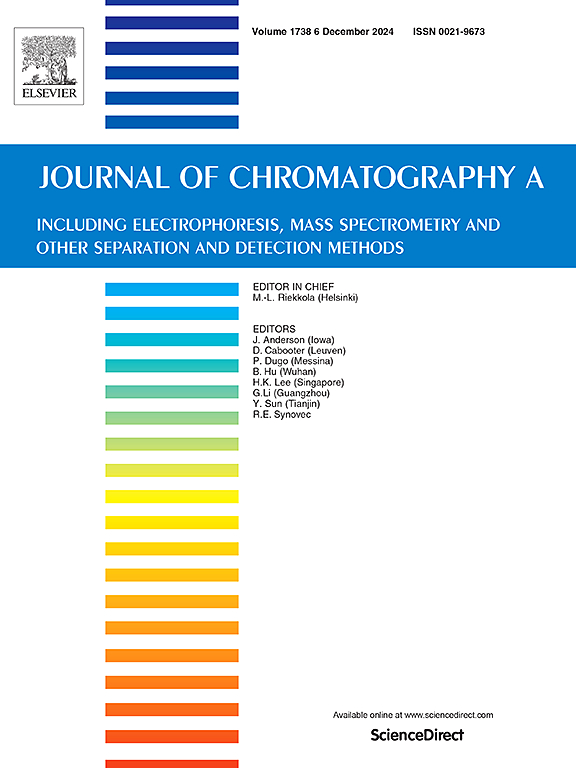Fingerprinting analyses of low molecular weight heparin with an orthogonal MHC 2D LC-MS system
IF 3.8
2区 化学
Q1 BIOCHEMICAL RESEARCH METHODS
引用次数: 0
Abstract
In this work, a synthetical glycan fingerprinting strategy using a multiple heart-cut two-dimensional liquid chromatography system linked to mass spectrometry (MHC 2D LC-MS) was developed to analyze enoxaparin, a widely used low molecular weight heparin (LMWH). Glycans from an enoxaparin standard were prepared offline based on size, and the derived tetra-, hexa-, octa- and decasaccharides were profiled using a qualitative analytical platform. Strong anion exchange chromatography (SAX) was employed as the first-dimensional chromatography (1D) to separate glycans of the same size but with different charges or sequences, while size exclusion chromatography (SEC) was used in the second dimension (2D) for desalting before MS analysis. The retention times (RTs), accurate masses and structural compositions of the glycans were fully characterized. Real samples were analyzed using the same platform but with 1D and 2D exchanged: SEC was used to separate enoxaparin glycans by size, followed by SAX using the same parameters as in the qualitative platform to separate glycans by charge or sequence. Glycans in real samples were identified by matching their RTs to those assigned in the qualitative analysis and semi-quantitated after normalization of peaks in each SAX chromatogram of glycans of different sizes. The analyses were performed automatically and robustly using this synthetical platform, enabling the fingerprinting and differentiation of enoxaparins from various sources. This platform could serve as a powerful tool for structural analysis, quality control, and heparin-related drug development.
利用正交 MHC 2D LC-MS 系统对低分子量肝素进行指纹分析。
本研究利用与质谱联用的多心切二维液相色谱系统(MHC 2D LC-MS)开发了一种合成糖指纹图谱策略,用于分析广泛使用的低分子量肝素(LMWH)依诺肝素。根据尺寸离线制备了依诺肝素标准品中的聚糖,并使用定性分析平台对衍生的四糖、六糖、八糖和十糖进行了分析。采用强阴离子交换色谱法(SAX)作为一维色谱法(1D)分离大小相同但电荷或序列不同的聚糖,而采用尺寸排阻色谱法(SEC)作为二维色谱法(2D)在质谱分析前进行脱盐。这些聚糖的保留时间(RT)、精确质量和结构组成都得到了充分表征。使用相同的平台对实际样品进行了分析,但进行了一维和二维交换:使用 SEC 按粒度分离依诺肝素聚糖,然后使用与定性平台相同参数的 SAX 按电荷或序列分离聚糖。实际样品中的聚糖是通过将其 RT 与定性分析中分配的 RT 匹配来识别的,并在对每个不同大小聚糖的 SAX 色谱图中的峰进行归一化后进行半定量分析。利用这一合成平台可以自动、稳健地进行分析,从而能够对不同来源的烯磷肽进行指纹识别和区分。该平台可作为结构分析、质量控制和肝素相关药物开发的有力工具。
本文章由计算机程序翻译,如有差异,请以英文原文为准。
求助全文
约1分钟内获得全文
求助全文
来源期刊

Journal of Chromatography A
化学-分析化学
CiteScore
7.90
自引率
14.60%
发文量
742
审稿时长
45 days
期刊介绍:
The Journal of Chromatography A provides a forum for the publication of original research and critical reviews on all aspects of fundamental and applied separation science. The scope of the journal includes chromatography and related techniques, electromigration techniques (e.g. electrophoresis, electrochromatography), hyphenated and other multi-dimensional techniques, sample preparation, and detection methods such as mass spectrometry. Contributions consist mainly of research papers dealing with the theory of separation methods, instrumental developments and analytical and preparative applications of general interest.
 求助内容:
求助内容: 应助结果提醒方式:
应助结果提醒方式:


